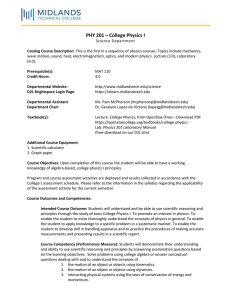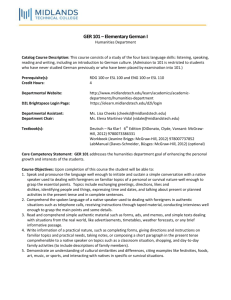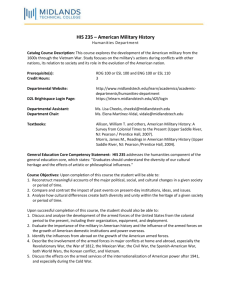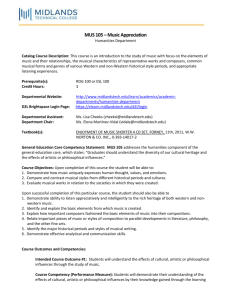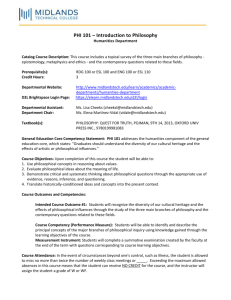Midlands Technical College BIO 102 – Biological Science II
advertisement
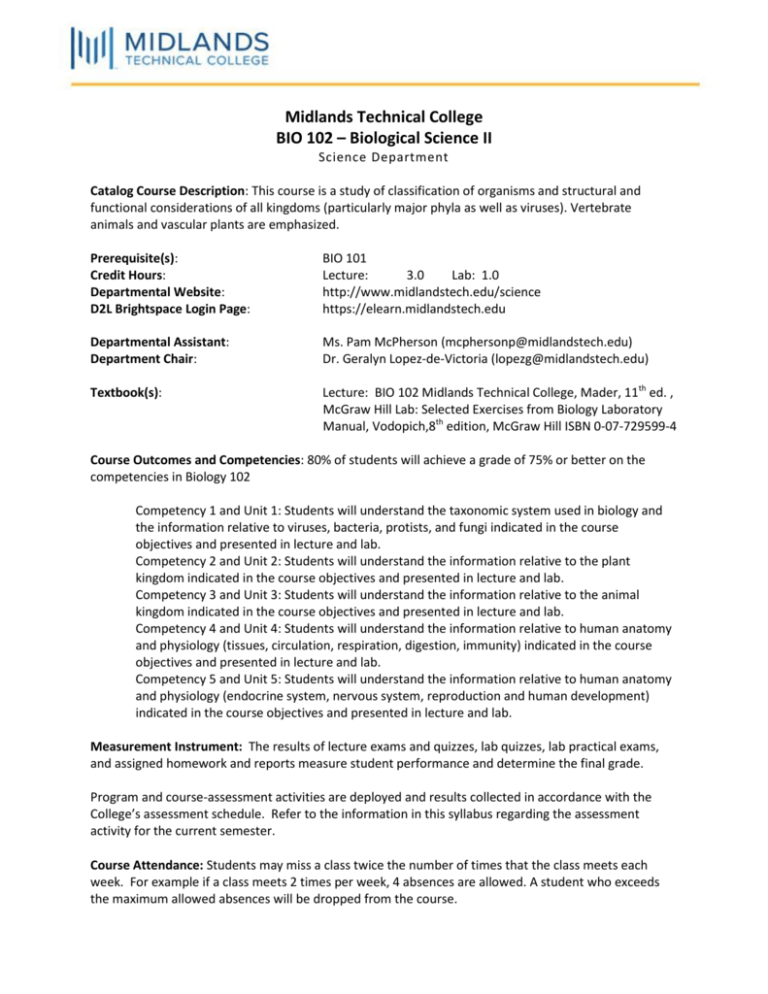
Midlands Technical College BIO 102 – Biological Science II Science Department Catalog Course Description: This course is a study of classification of organisms and structural and functional considerations of all kingdoms (particularly major phyla as well as viruses). Vertebrate animals and vascular plants are emphasized. Prerequisite(s): Credit Hours: Departmental Website: D2L Brightspace Login Page: BIO 101 Lecture: 3.0 Lab: 1.0 http://www.midlandstech.edu/science https://elearn.midlandstech.edu Departmental Assistant: Department Chair: Ms. Pam McPherson (mcphersonp@midlandstech.edu) Dr. Geralyn Lopez-de-Victoria (lopezg@midlandstech.edu) Textbook(s): Lecture: BIO 102 Midlands Technical College, Mader, 11th ed. , McGraw Hill Lab: Selected Exercises from Biology Laboratory Manual, Vodopich,8th edition, McGraw Hill ISBN 0-07-729599-4 Course Outcomes and Competencies: 80% of students will achieve a grade of 75% or better on the competencies in Biology 102 Competency 1 and Unit 1: Students will understand the taxonomic system used in biology and the information relative to viruses, bacteria, protists, and fungi indicated in the course objectives and presented in lecture and lab. Competency 2 and Unit 2: Students will understand the information relative to the plant kingdom indicated in the course objectives and presented in lecture and lab. Competency 3 and Unit 3: Students will understand the information relative to the animal kingdom indicated in the course objectives and presented in lecture and lab. Competency 4 and Unit 4: Students will understand the information relative to human anatomy and physiology (tissues, circulation, respiration, digestion, immunity) indicated in the course objectives and presented in lecture and lab. Competency 5 and Unit 5: Students will understand the information relative to human anatomy and physiology (endocrine system, nervous system, reproduction and human development) indicated in the course objectives and presented in lecture and lab. Measurement Instrument: The results of lecture exams and quizzes, lab quizzes, lab practical exams, and assigned homework and reports measure student performance and determine the final grade. Program and course-assessment activities are deployed and results collected in accordance with the College’s assessment schedule. Refer to the information in this syllabus regarding the assessment activity for the current semester. Course Attendance: Students may miss a class twice the number of times that the class meets each week. For example if a class meets 2 times per week, 4 absences are allowed. A student who exceeds the maximum allowed absences will be dropped from the course. If the student misses more than 10 minutes of class by either arriving late or leaving early, then the student will be counted as absent. Missing fewer than 10 minutes is a tardy. Three tardies count as one absence. Students adding courses after classes begin are responsible for work covered from the first day of class. All classes missed count as absences. Please note the following: You (the student) are responsible for all material and announcements presented, whether or not you are present for the class. Withdrawal: Students may withdraw from a course any time before the last week of classes (see the current semester college calendar, available on the MTC web site, for official dates). Students who wish to withdraw from a course must submit a withdrawal form to records. The date of withdrawal may affect a number of things, including financial aid/ tuition reimbursement, tuition refunds, and course grades. The effective date of withdrawal depends upon the date the withdrawal form is submitted to records. It is the student’s responsibility to be aware of relevant dates, to make an informed decision, and if necessary, to submit withdrawal forms in a timely fashion. For questions regarding the effect of withdrawal on financial aid or tuition reimbursement students should contact Student Financial Services. Deadlines for tuition refunds are posted on the current semester college calendar, and are available on the MTC web site, or by calling the cashier’s office. Students who withdraw before midterm will receive a grade of W. Students who withdraw after midterm and have an overall class average of 60% or greater will receive a grade of W. Students who withdraw after midterm and have an overall class average below 60% will receive a grade of WF, which is calculated as an F. Grades of W or WF are assigned when a student exceeds the maximum number of absences allowed in a course. These grades are entered on the final grade roster along with the last date of attendance (LDA). Students should understand that the LDA does not constitute an effective date of withdrawal and should not consider a decision to stop attending class to be equivalent to withdrawal. No Shows: If you register for a course and decide not to attend for any reason, you must complete a drop form and process it through the student Records Office. You will not be automatically purged for non-attendance. If you do not submit a drop form, you will be responsible for course tuition and fees. By not officially dropping the course, you will incur a bill with the college that can only be addressed through the College’s Finance Office. The college’s refund policy and dates are posted each semester. Effective Spring 2015, the Student Ombudsman’s office will no longer be the initial point of contact for requesting No Shows to be processed. Students who incur a bill must contact the Finance Office. Administrative Drop Requests: A student requesting an Administrative Drop resulting from medical event, death of family member, and other extenuating circumstances experienced while enrolled at Midlands Technical College should be directed to the Student Ombudsman’s office. Our policy dictates a request must be made no later than 30 days after the affected term. Supporting documentation is required and must be received before the request can be processed. Once the request form is received along with supporting documentation, it takes approximately three weeks for processing. As a result of an approved Administrative Drop Request, the student may be granted a refund of tuition and fees. Military Withdrawal: According to College Procedure 3.10.1, students having to withdraw from college because of Military Deployment (active duty personnel) while enrolled must complete a withdrawal form and submit to the Records Office along with a copy of military orders. Disabilities Statement: The staff of Counseling and Career Services works to ensure that all educational programming and services are accessible to otherwise qualified students with disabilities. If you have a concern regarding the accessibility of websites, instructional materials, online courses and other electronic or information technology please contact Counseling and Career Services. It is the student's responsibility to self-disclose as a student with a disability and to request accommodations prior to beginning a program or course. Please contact the staff of Counseling and Career Services at 803-8223505 (AC) or 803-738-7636 (BC) or via email at disability@midlandstech.edu if you have any questions or concerns. D2L Brightspace Help: Online Learning Support Help Desk: Technical questions related to the operation and use of D2L Brightspace can be answered from our Support Help Desk. A response will be provided within one business day. To login: use your MTC e-mail account username and password. (Student Username Example: georgeasmith) (Faculty Username Example: smithg) D2L Brightspace Assistance: Technical questions related to the operation and use of D2L Brightspace can also be answered by leaving a voicemail at (803) 822-3561, or emailing D2LHelp@midlandstech.edu. A response will be provided within one business day. MyMTC Help: For MyMTC log-in issues please call 803-738-7888. Academic Dishonesty: For more information about academic dishonesty, see the Academic Affairs Student Guidelines and Expectations attached. If you are suspected of cheating, your instructor will inform you. You may explain or refute the allegation. If your instructor still thinks the charges are founded, you will be referred to the Office of the AVP, SDS. Documentation is submitted to the Office of the AVP, SDS, by your instructor. You will then meet with either Dr. Holloway or Mr. Hayden. After the meeting, you will receive a letter with the sanction grade of zero (0) and any other sanctions deemed appropriate. You will have the right to file an appeal. Once the hearing and the notice of the right to appeal have been completed, the instructor will be notified to apply the sanction grade of zero (0). Course Requirements: The final grade for this course will be determined as follows: 75% Lecture and 25% Laboratory Five (5) lecture exams and one (1) cumulative final lecture exam will be equally weighted and averaged to determine the lecture grade. Instructors also may assign additional quizzes or outside work that will be factored into the lecture grade. Extra credit is not given. There will generally be 8 lab quizzes, a mid-term lab practical, and final lab practical exam. The average of the lab quizzes will count 75% of the lab grade. The average of the two lab practicals will count as 25% of the lab grade. Lab instructors may also require lab reports or outside work that will be graded and averaged into the “lab quiz” part of the lab grade. A grade of zero will be recorded for any announced exam or assignment which is missed. Academic Grading Scale: 90-100 80-89 70-79 60-69 0-59 A B C D F Superior Work Good Work Average Work Below Average Work Unsatisfactory Work PLEASE NOTE: The instructors reserve the right to adjust the requirements, pace, or scheduling of this course. Any changes to the schedule will be announced in class before they become effective. The faculty, coordinators and Science Department Chair are here to assist you. If you are having any difficulty with your class please talk to your instructor. After you have addressed your concerns with your instructor, you may wish to discuss them with the Science Coordinator for your campus. Dr. Gregory Mancini (738-7660) is Beltline Science Coordinator. Airport Science Coordinator is Mr. Tom Abrahamsen (822-3549). The Northeast Campus Science Coordinator is Dr. Ellison Robinson (691-3919). Finally, you may speak with the Department Chair, if necessary. Dr. Geralyne Lopez-de-Victoria is Department Chair. You may reach the Dept. Chair by calling Pam McPherson, Departmental Assistant (822-3548). Laboratory Policies and Safety Precautions: The laboratory is an integral part of the course. It supplements and complements material covered in lecture. Material may be presented in greater detail in lab than in lecture. The laboratory experience may include dissections, films, demonstrations, experiments, workbook exercises, research and writing assignments, and field trips. Approved field trips will occur, normally, during regularly scheduled lab periods. Students will provide their own transportation. Laboratory instructors will provide sufficient information and guidance to allow students to complete each lab, but success in lab primarily involves the individual effort of each student. To maximize learning and to minimize the risk of accidents or injury, the following policies and rules will be observed in science labs: 1. Students should read laboratory exercises before coming to class. 2. Laboratory exercises must be completed during the assigned lab period, unless otherwise designated by your instructor. 3. Do not disturb any equipment or demonstrations that have been set up until your instructor has told you how to proceed with the assignment. 4. Apply yourself in lab. The exercises are designed to reinforce and expand upon material presented in the lecture. 5. Follow directions carefully. 6. Do not hesitate to ask your lab instructor for clarification of any instructions you do not understand. However, do not expect your lab instructor to simply give you answers to information you should be obtaining through the completion of the various lab exercises. 7. Bring all necessary materials to class, including your text. 8. DO NOT BRING ANY FOOD OR DRINKS INTO ANY SCIENCE LAB. 9. Know where the eyewash station and shower are located in each lab. Report injuries immediately to your lab instructor. 10. Protective eyewear may be required in some labs. Students should have a set of goggles or safety glasses to wear during specified experimental procedures. 11. Open-toed footwear is a safety hazard. Such footwear is not allowed to be worn in the lab. While in the lab, students must wear shoes that completely cover their feet at all times. 12. Failure to wear proper footwear and eye safety equipment (when required) will result in dismissal from the lab for the day. 13. At the end of each lab, leave your work space in good order by discarding waste materials, cleaning and disinfecting your lab table, returning all materials used to their proper place, and sliding your chair back under the table 14. No visitors will be allowed lab or lecture sessions. Lecture Course Objectives: Upon completion of Biology 102, students should be able to: Unit I: 1. Give the major characteristics [cell type (prokaryotic or eukaryotic), number of cells (unicellular, multicellular, or colonial), nutrition autotrophic or heterotrophic)] for each of the five major kingdoms: Prokarya, Protista, Fungi, Plant and Animal. 2. Demonstrate the rules for modern taxonomic nomenclature (binomial nomenclature). List the major taxa in order: Kingdom, phylum, class, order, family, genus, species. 3. Describe the major characteristics of the Prokarya, Protista, Fungi, Viruses including structure and diversity presented in lecture. 4. Describe the examples of protists, viruses, fungi, and bacteria presented in the Biology 102 Study Guide and in lecture Unit II: 1. Compare Bryophytes, Pteridophytes, Gymnosperms, and Angiosperms on the basis of (a) vascular or non-vascular plants, (b) spore or seed-producers, (c) pollen production or not (d) flower or fruit production or not and (e) primary means of spore and seed dispersal. 2. Give the major examples of Bryophytes (and relatives), Pteridophytes (and relatives), Gymnosperms (and relatives), and Angiosperms presented in lecture and the Biology 102 Study Guide. 3. Describe pollination and the importance of the "double fertilization" process found in angiosperms. 4. Among angiosperms, compare monocots to dicots based on number of cotyledons, stem vascular arrangement, floral numbers and major examples. Unit III: 1. Give a general description and list representative species for each of the following animal phyla and classes: Porifera, Cnidaria, Platyhelminthes (Cestoda, Turbellaria, Trematoda), Nematoda, Mollusca (Gastropoda, Bivalvia, Cephalopoda), Annelida (Oligochaeta, Polychaeta, Hirudinea), Arthropoda (Crustacea, Chilopoda, Diplopoda, Arachnida, Insecta), Echinodermata (Asteroidea, Crinoidea, Echinoidea, Ophiuroidea, Holothuroidea), Chordata (Agnatha, Chondrichthyes, Osteichthyes, Amphibia, Reptilia, Aves, Mammalia). 2. For each of the animal phyla and classes listed describe how the following essential life processes or systems are accomplished: nutrition, digestion, circulation, gas exchange, nervous system, muscular system, skeletal system, excretion. 3. Classify each of the animal phyla listed as either: (a) protostomates or dueterostomates; and either (b) acoelomates, pseudocoelomates, or eucoelomates. Unit IV: 1. Compare the following basic tissue types: epithelial, connective, muscle, and nerve based on: (a) cell structure, (b) function, and (c) major categories and examples. 2. Describe how proteins, carbohydrates, lipids, and nucleic acids are processed and digested in the human digestive system. Name all important enzymes involved, the organ from which each enzyme is secreted and the specificity of each enzyme. 3. Trace the path of blood through the human systemic and pulmonary circulatory system naming the important vessels and structures along the way. Include in your answer: right atrium, tricuspid valve, left atrium, bicuspid (Mitral valve), left ventricle, aortic semilunar valve, pulmonary semilunar valve, pulmonary artery, pulmonary vein, superior and inferior vena cava, hepatic portal circulation. 4. Describe the function of the SA node and how cardiac cycle works (systolic and diastolic phases). 5. Relate the following portions of an EKG wave to the cardiac cycle: p wave, QRS complex, t wave. 6. Discuss the composition and functions of blood including an analysis of plasma, as well as, the major categories of formed elements (cells) including: plasma, plasma proteins, fibrinogen, immunoglobulins, erythrocytes, leucocytes (neutrophils, eosinophils, basophils, monocytes, lymphocytes), and thrombocytes. 7. Describe the specific immune response including the role played by the T cells and B cells. 8. Describe the nonspecific lines of immune defense including: skin, inflammation response, interferon, complement proteins, and the role of the leucocytes (basophils, eosinophils, neutrophils, and monocytes). 9. Describe the structure of an antibody and define what is meant by an antigen. 10. Contrast active and passive and natural and artificial immune responses. 11. Describe the following autoimmune disorders: lupus, rheumatoid arthritis, Type 1 Diabetes. Unit V: 1. Name the endocrine glands (pituitary, hypothalamus, thymus, pineal, thyroid, parathyroid, adrenal cortex and medulla, pancreas, ovary, testes) describing the hormones each gland secretes and the functional role of each hormone. 2. Describe the physiology of a nerve impulse including the following terms: active transport, sodium-potassium pump, sodium and potassium channels, depolarization, repolarization, myelin sheath, node of Ranvier, saltatory conduction, axon, dendrite, neurotransmitters). 3. Describe the role of the following neurotransmitters: dopamine, serotonin, epinephrine, acetylcholine, GABA, glycine. 4. Describe the role of the following parts of the nervous system: cerebrum, cerebellum, medulla, limbic system, reticular activating system, corpus callosum, hypothalamus, thalamus. 5. Compare the sympathetic and the parasympathetic divisions of the autonomic nervous system. 6. Name and describe the component parts of a reflex arc. 7. List the major structures associated with the male and female reproductive system. Describe the function of each of the major structures. 8. Compare spermatogenesis to oogenesis. 9. Define the following terms: gamete, zygote, morula, blastula, gastrula, cleavage divisions. 10. Describe the role of estrogen, progesterone, FSH, LH, and HCG during the menstrual cycle, ovarian cycle, and pregnancy. Course Topic Outline/Course Calendar with Assignments: BIO 102 Lecture Schedule Current Week Week 1 Topics Covered Introduction Classification of Living Things Viruses Week 2 Bacteria and Archaea Protist Evolution and Diversity Week 3 Fungi Evolution and Diversity Exam I Week 4 Plant Evolution and Diversity Plant Structure Plant Nutrition/Transport Week 5 Reproduction in Flowering Plants Week 6 Control of Plant Growth and Response Week 7 Exam II Introduction to Animals Week 8 Invertebrate Evolution Sponges to Roundworms Week 9 Mollusks to Arthropods (The Prostomes) Invertebrate Deuterostomes Vertebrate Evolution and Diversity Week 10 Exam III Introduction to Animal Organization and Homeostasis, Tissues, Organ Systems Week 11 Circulatory System Respiratory System (Topics) Lymphatic System/Immunity Week 12 Digestive System and Nutrition Exam IV Hormones and Endocrine System Week 13 Neurons and Nervous System Reproduction Week 14 Human Development Exam V Final Exam Period Cumulative Final - TBA Chapter 19 20 20 21 22 19-22 23 24 25 27 26 23-27 28 28 28 28 28 29 28-29 31 31 32 35 33 34 31-35 40 37 41 42 37, 40-42 BIO 102 Lab Schedule Current Week Week 1 Week 2 Week 3 Week 4 Week 5 Week 6 Week 7 Week 8 Week 9 Week 10 Topics Covered Intro and Safety Microscope Review Bacteria Microscope and Bacteria Algae Protists Fungi Plants: Liverworts, Hornworts, Mosses Protists, Fungi, SNV Plants Seedless Vascular Plants Gymnosperms SVPs and Gymnosperms Angiosperms Plant Anatomy (roots, stems, leaves, flowers) Angiosperms and Plant Anatomy Animal Kingdom: Porifera and Cnidaria (Microscope, Prokarya, Protista, Fungi, Plants) Platyhelminthes and Nematoda Mollusks and Annelida Animals: Porifera, Cnidaria, Platyhelminthes, Nematoda Arthropods Echinoderms Animals: (Annelida, Arthropoda, Mollusca) Chordates Vertebrate Tissues Human Skeletal System Week 11 Echinoderms, Chordates, Human Skeleton Human Biology: Breathing/Spirometry Human Biology: Circulation and Blood Pressure Week 12 Sensory Perception / Nervous System Week 13 Spirometry, Circ. system, Heart Structure and Sensory Organs Focus on Digestive, Endocrine, Urinary, Reproductive Systems Animal Kingdom and Anatomy and Physiology Week 14 Activity Exercise 03 Exercise 24 Quiz 1 Exercise 25 Exercise 26 Exercise 27 Exercise 28 Quiz 2 Exercise 29 Exercise 30 Quiz 3 Exercise 31 Exercise 32 Quiz 4 Exercise 36 Review for Lab Practical 1 Lab Practical 1 Exercise 37 Exercise 38 Quiz 5 Exercise 39 Exercise 40 Quiz 6 Exercise 40 (continued) Exercise 41 Exercise 42 Quiz 7 Exercise 44 Exercise 45 Heart Dissection Exercise 46 Dissection of Ox Eye and Sheep’s Brain Quiz 8 Appendix I Dissection of Fetal Pig Review for Lab Practical 2 Lab PracticalII
